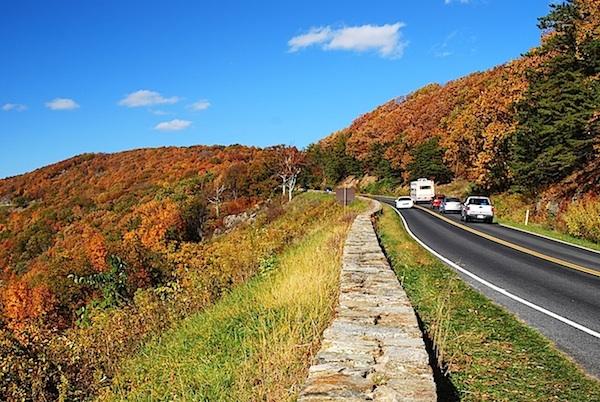
Fall colors dazzle motorists on the Skyline Drive through Shenandoah National Park/Kurt Repanshek
It matters little whether you start in the south and drive north, or start in the north and drive south; the fall finery that cloaks the Appalachian Range has few peers when the climatic conditions converge in mid-October.
Oaks, maples, beech, sweetgum, and hickories collaborate to dazzle you with hues of Cabernet, cranberry, orange, gold and rust, some of which are set against the greenery of pines and hemlocks. Creeping along the forest floor, sassafrass, Virginia creeper, and even patches of purple asters provide a colorful contrast to the showy overstory.
The challenge you face, though, is the traffic this festival of fall foliage attracts. Bumper-to-bumper conditions can clog the 105-mile-long Skyline Drive through Shenandoah National Park, the 469-mile Blue Ridge Parkway, and even the 34-mile-long Newfound Gap Road in Great Smoky Mountains National Park.
What to do? Strategies vary. If you're coming from afar, you should already have your lodging reservations in Shenandoah or one of the properties tied to the Blue Ridge Parkway. If you don't, hope for a cancellation or look to the gateway towns and their B&B ranks. If you enjoy sleeping on the ground, act quickly and snatch a spot in one of the campgrounds by going to recreation.gov.
Whether you're staying just outside one of the parks, or lucked out with a room within, forgoe a driving tour and instead make incursions into the forests on foot. Avoid the most popular spots ' Old Rag in Shenandoah, Mount Mitchell along the Blue Ridge Parkway, and Mount LeConte in Great Smoky ' and focus on trails that might not draw as many crowds. After all, the foliage is spectacular whether you're viewing it from Old Rag or Moormans River Overlook in Shenandoah, from Mabry Mill or Crabtree Falls on the Blue Ridge Parkway, or from Cades Cove or Balsam Mountain in Great Smoky.
Make a point to rise early and have a late dinner. The sharp, early morning sun, and the waning evening sun, offer the best colors for photos and tend to coincide with lesser traffic on the roads and trails. Weekdays also are less crowded than weekends. Whenever you go, be sure your gas tank and picnic basket are full, your camera charged, and your flashcard empty at the outset!



Comments
To keep up to date with foliage conditions in Acadia National Park, one strategy may be to link to a park Web cam on McFarland Hill, across from park headquarters. While the cam is to monitor air quality, it includes the top of some trees.
In addition, there is an official Maine foliage Web site with a weekly foliage report by area of the state. As of this week's report, the region that includes Acadia isn't quite at peak yet.
You can link to the park Web cam and the state foliage site in our latest blog post, and read about why noted photographer QT Luong, Martha Stewart, National Parks Traveler, Backpacker Magazine and the Wilderness Society, all highly rate Acadia's foliage.
http://acadiaonmymind.com/2014/10/fall-foliage-acadia-national-park-leaf...
Driving around Alaskan and Canadian parks over the past month I've seen brilliant colors. The most brilliant, of course, were the day after my eyes were dilated for an exam, but otherwise the colors have been naturally wonderful as well.
When was that picture taken??
I believe October 2012...